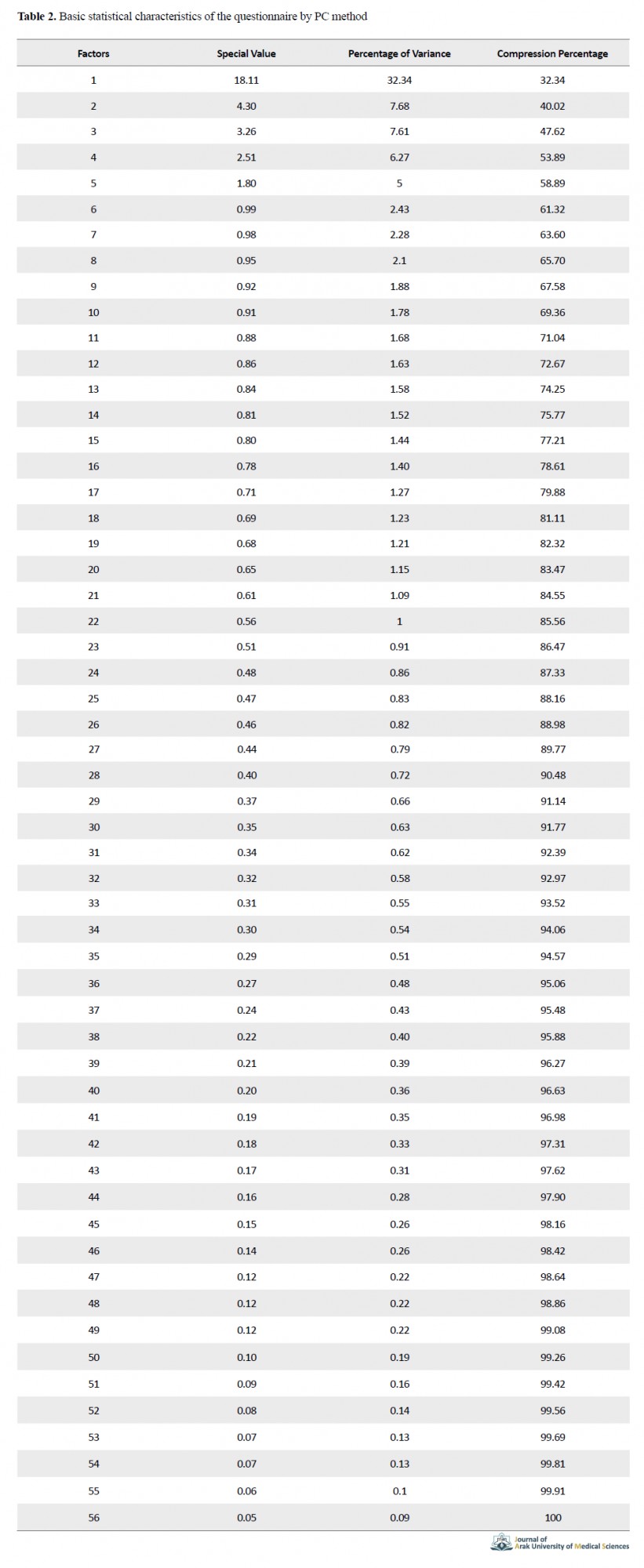Volume 23, Issue 4 (October & November 2020)
J Arak Uni Med Sci 2020, 23(4): 550-569 |
Back to browse issues page
Download citation:
BibTeX | RIS | EndNote | Medlars | ProCite | Reference Manager | RefWorks
Send citation to:



BibTeX | RIS | EndNote | Medlars | ProCite | Reference Manager | RefWorks
Send citation to:
Mortazavi S M, Sharifirad G, Mohebi S. Identifying Qualitative Factors Affecting the Quality of Clinical Education. J Arak Uni Med Sci 2020; 23 (4) :550-569
URL: http://jams.arakmu.ac.ir/article-1-6299-en.html
URL: http://jams.arakmu.ac.ir/article-1-6299-en.html
1- Department of Educational Management, Faculty of Humanities, Qom Branch, Islamic Azad University, Qom, Iran.
2- Department of Social Sciences, Faculty of Humanities, Islamic Azad University, Qom Branch, Islamic Azad University, Qom, Iran. ,dr.sharifirad@gmail.com
3- Department of Health Sciences, School of Health, Qom University of Medical Sciences, Qom, Iran.
2- Department of Social Sciences, Faculty of Humanities, Islamic Azad University, Qom Branch, Islamic Azad University, Qom, Iran. ,
3- Department of Health Sciences, School of Health, Qom University of Medical Sciences, Qom, Iran.
Full-Text [PDF 6025 kb]
(1573 Downloads)
| Abstract (HTML) (2946 Views)
Full-Text: (2330 Views)
1. Introduction
linical education is one of the most important pillars of medical students’ education. Because this education is the operational stage of theoretical education, it should be able to institutionalize the learned knowledge in learners with the help of experienced professors and hospital facilities in a way that has the most impact. Clinical education is the most important part of medical education, which is an integral part of it, which is known as the heart of vocational education. During clinical training, what is learned is put into practice, skills are taught, and students have confronted with the realities of the workplace and this study aim to explore the qualitative factors in clinical education provided in Saveh hospitals because each region has specific cultures and educational processes, as well as problems in each university, are different that justifies the need for this research.
2. Materials and Methods
To understand the phenomenon, this research starts with qualitative data, and then the secondary or quantitative stage is made. Therefore, this study is a combination of studies and exploratory projects. In the qualitative stage, to explain the quality of clinical education, the qualitative method of Grand Strauss and Corbin 1998 was used. Considering that the students who took clinical courses in the Faculty of Medical Sciences in 2018-2019 were about 200 people and the professors and instructors who teach these people were about 20 people, according to Karajsi and Morgan table the sample size should be 140 people, of which 20 participated in the interview and 120 people filled out a paper and electronic questionnaire. In this study, semi-structured interviews were selected as the method of data collection. Each interview was then coded. The interviews were completely and accurately transcribed using MAXQDA 10 software while collecting information, and the initial coding was done at the same time in the initial coding, the researcher examined the transcribed or typed data line by line as units of analysis, and the coding was performed based on qualitative findings.
3. Results
Considering that the KMO value was equal to 0.860 and the significance level of the Bartlett sphericity test was less than 0.01, the reliability was also calculated that the total reliability of the questionnaire in this study was 0.958, which is excellent. And the results of this research are as follows:
First Factor: space, facilities, shortages, and educational needs that the nutrition factor and welfare facilities with the number 0.774 and training rooms in the wards of hospitals with 0.761, and the use of equipment and consumables of hospitals 0.729. These were among the three main factors that had the highest scores.
Second Factor: Results and consequences of improving educational processes that increase the level of patient safety with a score of 0.806 and increase patient satisfaction with a score of 0.776, and achieve hospital goals and customer satisfaction with a score of 0.747.
Third Factor: educational and managerial deficiencies, lack of a specific lesson plan with a score of 0.762, lack of a stable faculty member with a score of 0.743, and the factor of students’ participation with professors in educational processes with a score of 0.741.
Fourth Factor: The correct cases of educational evaluation that the experienced teacher with a score of 0.806, the teacher and students with a participatory spirit with a score of 0.756, and the factor that clinical teachers have a suitable quality with a score of 0.741.

Fifth Factor: Improving the quality of education and improving educational processes, which is the factor of using material and spiritual motivations for students with a score of 0.840, the factor of using new educational facilities in clinical education with a score of 0.825, and using in-service training classes to empower teachers with a score of 0.802 obtained the highest scores (Tables 1 & 2).

First Factor: space, facilities, shortages, and educational needs that the nutrition factor and welfare facilities with the number 0.774 and training rooms in the wards of hospitals with 0.761, and the use of equipment and consumables of hospitals 0.729. These were among the three main factors that had the highest scores.
Second Factor: Results and consequences of improving educational processes that increase the level of patient safety with a score of 0.806 and increase patient satisfaction with a score of 0.776, and achieve hospital goals and customer satisfaction with a score of 0.747.
Third Factor: educational and managerial deficiencies, lack of a specific lesson plan with a score of 0.762, lack of a stable faculty member with a score of 0.743, and the factor of students’ participation with professors in educational processes with a score of 0.741.
Fourth Factor: The correct cases of educational evaluation that the experienced teacher with a score of 0.806, the teacher and students with a participatory spirit with a score of 0.756, and the factor that clinical teachers have a suitable quality with a score of 0.741.

Fifth Factor: Improving the quality of education and improving educational processes, which is the factor of using material and spiritual motivations for students with a score of 0.840, the factor of using new educational facilities in clinical education with a score of 0.825, and using in-service training classes to empower teachers with a score of 0.802 obtained the highest scores (Tables 1 & 2).

4. Discussion and Conclusion
This study aims to identify the factors affecting the quality of clinical education in hospitals in Saveh City. According to the quantitative and qualitative results of this research and by interviewing twenty experienced professors and student representatives, the first factor is space and facilities and shortages and educational needs, which is the factor of nutrition and welfare facilities with a score of 0.774 and training rooms in hospital wards with 0.761 and the use of equipment and consumables of hospitals 0.729. These are among the three main factors that have the highest scores.
The second factor is the results and consequences of improving educational processes that increase the level of patient safety with a score of 0.806 and increase patient consent with a score of 0.776 and achieve hospital goals and customer satisfaction with a score of 0.747.
The third factor is educational and managerial deficiencies with the lack of a specific lesson plan with a score of 0.762, the lack of a stable faculty with a score of 0.743 and the factor of students’ participation with professors in educational processes with a score of 0.741.
The fourth factor is the teacher evaluation, and the correct cases of educational evaluation in which the experienced teacher with a score of 0.806, the teacher with the students have a participatory spirit with a score of 0.756 and the factor that the professors of clinical education have a suitable quality have a score of 0.741.
The fifth factor is to improve the quality of education and improve the educational processes, which is the factor of using material and spiritual motivations for students with a score of 0.840, the factor of using new educational facilities in clinical education with a score of 0.825 and using educational classes. While serving to empower the professors with a score of 0.802, they obtained the highest scores, and since different factors and even the prevailing cultures in each university are different from each other, it is not possible to prescribe a single version for everyone, but research results can be used to synergize knowledge and awareness for other research.
The second factor is the results and consequences of improving educational processes that increase the level of patient safety with a score of 0.806 and increase patient consent with a score of 0.776 and achieve hospital goals and customer satisfaction with a score of 0.747.
The third factor is educational and managerial deficiencies with the lack of a specific lesson plan with a score of 0.762, the lack of a stable faculty with a score of 0.743 and the factor of students’ participation with professors in educational processes with a score of 0.741.
The fourth factor is the teacher evaluation, and the correct cases of educational evaluation in which the experienced teacher with a score of 0.806, the teacher with the students have a participatory spirit with a score of 0.756 and the factor that the professors of clinical education have a suitable quality have a score of 0.741.
The fifth factor is to improve the quality of education and improve the educational processes, which is the factor of using material and spiritual motivations for students with a score of 0.840, the factor of using new educational facilities in clinical education with a score of 0.825 and using educational classes. While serving to empower the professors with a score of 0.802, they obtained the highest scores, and since different factors and even the prevailing cultures in each university are different from each other, it is not possible to prescribe a single version for everyone, but research results can be used to synergize knowledge and awareness for other research.
Ethical Considerations
Compliance with ethical guidelines
This study was approved by the Research Priorities of Saveh School of Medical Sciences, (Code: 24.127. D.99).
Funding
The present paper was extracted from the PhD. dissertation of the first author, Department of Educational Management, Faculty of Humanities, Qom Branch, Islamic Azad University, Qom.
Authors' contributions
Conceptualization, Methodology: Seyed Mostafa Mortazavi, Gholamreza Sharifirad; Data analysis, Writing – original draft, and Writing – review & editing: All Authors.
Conflicts of interest
The authors declared no conflict of interest.
Type of Study: Qualitative Study |
Subject:
Basic Sciences
Received: 2020/04/21 | Accepted: 2020/07/11
Received: 2020/04/21 | Accepted: 2020/07/11
Send email to the article author
| Rights and permissions | |
 |
This work is licensed under a Creative Commons Attribution-NonCommercial 4.0 International License. |









